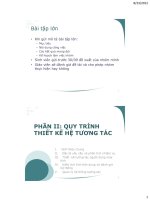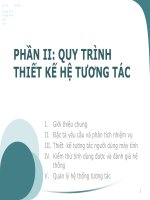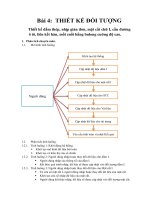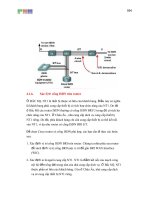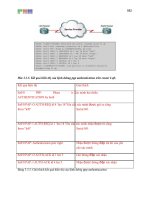Observer (THIẾT kế đối TƯỢNG SLIDE)
Bạn đang xem bản rút gọn của tài liệu. Xem và tải ngay bản đầy đủ của tài liệu tại đây (1.39 MB, 35 trang )
Observer Pattern
Keeping your Objects in the Know!
1
Observer – A Non Software Example
2
Motivation Weather Station
• Build a weather monitoring station that have
– Weather Station – hardware device which collects data from
various sensors (humidity, temperature, pressure)
– WeatherData object which interfaces with the Weather
Station hardware
• Need to implement three display elements that use the
WeatherData and must be updated each time
WeatherData has new measurements
– a current conditions display Temp, Humidity, Pressure change
– a weather statistics display Avg. temp, Min. temp, Max. temp
– and a forecast display
• The system must be expandable
– can create new custom display elements and can add or remove
as many display elements as they want to the application.
3
A Weather Monitoring Application
What we have
What we need
to implement
Temperature sensor
device
Weather forecast
Presure sensor
device
Weather
station
Humidity sensor
device
Weather data
object
Current conditions
Weather statistics
4
The WeatherData class
WeatherData
+ getTemperature()
+ getHumidity()
+ getPressure()
+ measurementChanged()
// other methods
These three methods return the most recent
weather measurements for temperature,
humidity, and pressure respectively.
We don’t care HOW these variables are set;
the WeatherData object knows how to get
updated information from the WeatherStation
This method is called anytime new
weather measurement data is available
5
A First Misguided Attempt at the
Weather Station
public class WeatherData {
// instance variable declarations
public void measurementsChanged() {
Grab the most recent
float temp = getTemperature(); measurements by calling the
float humidity = getHumidity(); WeatherData’s getter methods
float pressure = getPressure(); (already implemented)
currentConditionsDisplay.update(temp, humidity,
pressure);
statisticsDisplay.update(temp, humidity, pressure);
forecastDisplay.update(temp, humidity, pressure);
Now update the displays.
}
// other WeatherData methods here
}
Call each display element to
update its display, passing it
the most recent measurements.
6
What’s wrong with the first
implementation?
public class WeatherData {
// instance variable declarations
public void measurementsChanged() {
float temp = getTemperature();
float humidity = getHumidity(); Area of change, we need
float pressure = getPressure(); to encapsulate this.
currentConditionsDisplay.update(temp, humidity,
pressure);
statisticsDisplay.update(temp, humidity, pressure);
forecastDisplay.update(temp, humidity, pressure);
}
// other WeatherData methods here
At least we seem to be using a common
}
By coding to concrete implementations
we have no way to add or remove other
display elements without making changes
to the program.
interface to talk to the display elements …
They all have an update() method that
takes temp, humidity and pressure values.
7
Publisher + Subscriber = Observer
When data in the WeatherData
object changes, the observers are
notified
Weather forecast
The displays have
subscribed with the
WeatherData to
receive updates when
the WeatherData
changes
Weather
data object
New data values are
communicated to the observers
in some form when they change
This object isn’t an
observer so it doesn’t
get notified when the
subject data changes
Current conditions
Weather statistics
Observer
objects
8
Adding Observers
• A TV station comes along and tells the Weather data
that it wants to become an observer
register/
subscribe me
9
Adding Observers
• The TV station is now an official observer
– It gets a notification when the Weather object has
changed
10
Removing Observers
• One of the displays asks to be removed as an
observer
Remove /
Unsubscribe me
11
Removing Observers
• All the other observers can get another notification
except the the display that has been recently
removed from the set of observers
12
Design Principle
Strive for loosely coupled designs
between objects that interact.
• Loosely coupled designs allow us to build flexible
OO systems that can handle changes because they
minimize the interdependency between objects.
13
The Constitution of Software Architects
• Encapsulate what varies
• Program through an interface not to an implementation
• Favor Composition over Inheritance
• Classes should be open for extension but closed for
modification
• Strive for loosely coupled designs between objects that
interact.
• ?????????
• ?????????
• ?????????
• ?????????
14
The Observer Pattern
• Define a one-to-many dependency between objects so
that when one object changes state, all its dependents
are notified and updated automatically.
Motivation for
Observer Pattern
15
Structure Observer Pattern
Knows its numerous observers. Provides an interface for
attaching and detaching observer objects.
Sends a notification to its observers when its state changes.
Subject
+attach(o: Observer)
+detach(o: Observer)
+notify()
ConcreteSubject
<<interface>>
Observer
0..*
Defines an update
interface for concrete
observers, that gets
called when the
Subject’s state changes.
+update()
for all o in observers {
o.update()
}
ConcreteObserver
-subject
-subjectState: Object
-obseverState: Object
+getState(): Object
+setState(o: Object)
+update()
A concrete subject always implements the
Subject interface. In addition to the register
(attach) and remove (detach) methods, the
concrete subject implements a notify() method
to notify observers whenever state changes.
Concrete observers can
be any class that
implements the Observer
interface. Each observer
registers with a concrete
subject to receive updates.
observerState=
subject.getState()
16
Consequences
• Abstract coupling between subject and observer
– Coupling is abstract, thus minimal
(concrete class isn’t known).
– Can have multiple layers of abstraction.
• Support for broadcast communication
– Subject doesn’t need to know its receivers.
• Unexpected updates
– Can be blind to some changes in the subject
(i.e., observer doesn’t know “what” has changed in
the subject).
17
Designing the Weather Station
<<Interface>>
Subject
0..*
+ registerObserver(o:Observer)
+ removeObserver(o:Observer)
+ notifyObservers()
Subject interface
WeatherData
+ getTemperature() : double
+ getHumidity() : double
+ getPressure() : double
+ measurementChanged()
+ registerObserver(o : Observer)
+ removeObserver(o : Observer)
+ notifyObservers()
WeatherData now
implements the Subject
interface.
<<Interface>>
Observer
+ update()
All weather
components
implement
the
Observer
interface.
<<Interface>>
DisplayElement
+ display()
ForecastDisplay
+ update()
+ display()
CurrentConditionDisplay
StatisticDisplay
+ update()
+ display()
+ update()
+ display()
18
Implementing the Weather Station
public interface Subject {
public void registerObserver(Observer o);
public void removeObserver(Observer o);
public void notifyObservers();
}
public interface Observer {
public void update(float temp, float humidity, float
pressure);
}
public interface DisplayElement
public void display();
}
{
These
are the state values
the Observers get from
the Subject when a
weather measurement
changes.
19
Implementing the Subject Interface
public class WeatherData implements Subject {
private List<Observer> observers;
private float temperature;
Added an ArrayList to hold
private float humidity;
the Observers, and we create it
private float pressure;
in the constructor
public WeatherData() {
observers = new ArrayList<Observer>();
}
public void registerObserver(Observer o) {
observers.add(o);
}
Here we implement
public void removeObserver(Observer o) {
observers.remove(o);
the Subject Interface
}
public void notifyObservers() {
for (Observer o : observers) {
o.update(temperature, humidity, pressure);
}
}
public void measurementsChanged() {
Notify the observers when
notifyObservers();
measurements change.
}
}
20
The Display Elements
The constructors passed
the weatherData
public class CurrentConditionsDisplay
object (the subject) and
implements Observer, DisplayElement { we use it to register the
private float temperature;
display as an observer.
private float humidity;
public CurrentConditionsDisplay(Subject weatherData) {
weatherData.registerObserver(this);
}
public void update(float temperature, float humidity,
float pressure) {
this.temperature = temperature;
When update() is called,
this.humidity = humidity;
we save the temp and
display();
humidity and call display()
}
public void display() {
System.out.println("Current conditions : "
+ temperature + "F degrees and "
+ humidity + "% humidity");
}
}
21
TestDrive
public class WeatherStation {
public static void main(String[] args) {
WeatherData weatherData = new WeatherData();
CurrentConditionsDisplay currentDisplay =
new CurrentConditionsDisplay(weatherData);
StatisticsDisplay statisticsDisplay =
new StatisticsDisplay(weatherData);
ForecastDisplay forecastDisplay =
new ForecastDisplay(weatherData);
weatherData.setMeasurements(80, 65, 30.4f);
weatherData.setMeasurements(82, 70, 29.2f);
weatherData.setMeasurements(78, 90, 29.2f);
}
}
22
Java’s Built-in Observer Pattern
•
For an Object to become an Observer:
– Implement the java.util.Observer interface
and call addObserver() on any Observable
object. To remove use deleteObserver()
method.
•
For the Observable to send notifications
– Extend java.util.Observable superclass
– Then a 2 step process:
1. First call the setChanged() method to signify that
the state has changed in your object.
2. call one of two methods: notifyObservers() or
notifyObservers(Object arg)
•
For the Observer to receive notifications
– Implement the update() method as before
update(Observable o, Object arg)
23
Java’s Built-in Observer Pattern
• Observer == Observer
• Observable == Subject
WeatherData does not need
to implement register, remove
and notify -- it inherits them
24
WeatherData extends the
Observable
public class WeatherData extends Observable {
private float temperature;
private float humidity;
private float pressure;
public WeatherData() { }
public void measurementsChanged() {
setChanged();
notifyObservers();
}
public void setMeasurements(
float temperature, float humidity, float
pressure) {
this.temperature = temperature;
this.humidity = humidity;
this.pressure = pressure;
measurementsChanged();
}
25

